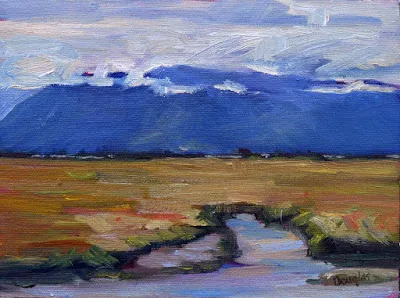Want to write a successful art blog? Be brief, punchy, disciplined and focused.
 |
| Barnum Brook, by Carol L. Douglas. (Private collection) Your blog is primarily to promote your brand, so use your own photos when you can. |
I used to post whenever I had a new painting or brilliant thought. That’s how most artists post, and it doesn’t work. To succeed, you must commit to writing on a regular basis. Twice a week is the bare minimum. I now blog five days a week, excluding major holidays.
When I tell people this, they sometimes object:
- I can’t write fast enough to do that;
- I don’t want the internet taking over my life;
- That sounds like too much work.
This blog takes me 90 minutes a day. I do it before I get out of bed. Unless I’m doing bookkeeping or marketing, I seldom open my laptop again for the rest of the day.
I can only do that because I keep a list of future topics on my laptop. I almost always go to bed at night knowing what the subject will be the next day.
A blog post should tell a story. Consider this postabout Crista Pisano’s dead battery. Not much happened in absolute terms, but it ended up being a powerful story about women helping each other.
If you’re literate, you can blog. But some people hate to write. They should consider Instagram instead. My Instagram feed is the back story to my paintings. I use it to post the funny or charming things that happen on the way to a painting.
Be brief. Today more than half my readers read my blog on their phones, rather than on a computer. Brevity and punch are more important than ever before. If you have a lot to say on a subject, as I do here, write it over multiple days.
The most important part of the post is the headline and the tagline that follows it. I write these after the post is finished. Use important keywords here, because this is what search engines will see.
I try to cover the basics of a story as taught by my high-school journalism teacher: who, what, why, where, when and how. But other elements of ‘good’ writing go by the wayside—there’s no introductory paragraph and no closing paragraph.
After I’ve written my post, I edit viciously to bring it in under 600 words.
You’re using your blog to promote your own brand. This is a great opportunity to use your own photos. Even so, if your work is in a gallery, be sure to link to it in the caption.
| Below Ottawa House, by Carol L. Douglas, courtesy Kelpie Gallery. |
If you’re using another person’s photo, obtain their consent in advance and credit them for the picture. Do not, under any circumstances, use uncredited images from the internet. That violates copyright law.
You can use work in the public domain, including artwork owned by museums who make that work available to the public. However, even if a painting is exempt from copyright law, the photo of the painting may be owned by someone. Wikipedia gives instructions for crediting pictures. In the case of a museum, credit the organization.
The Fair Use exemption allows reproduction to comment upon, criticize, or parody a copyrighted work. I use photos of others’ work under this exemption when I write about art history or contemporary art. Go carefully; Jeff Koons has gotten in trouble repeatedly for stomping on others’ copyright. Consult an intellectual-property lawyer if you have questions.
Several people at Maine International Conference on the Arts (MICA) asked me for more detailed information on marketing on social media. This is part two of a series on the subject.
Part three: Getting readers
Feel free to comment or ask me questions, below.








